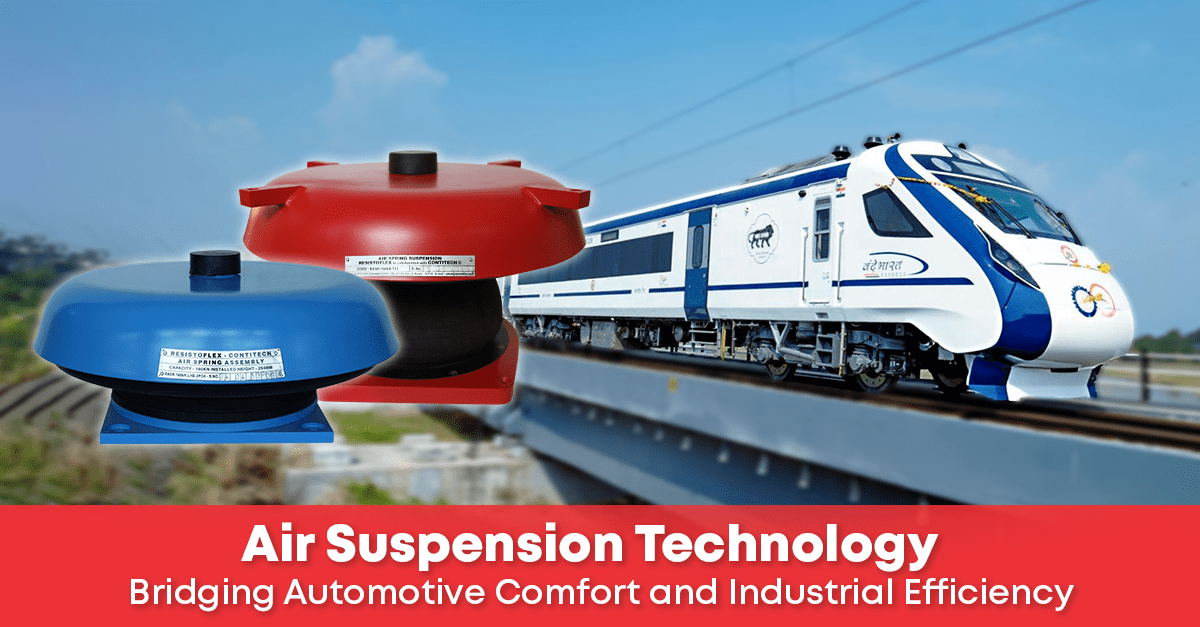Air Suspension Technology
- 20 Nov 2024
- Air Suspension Technology
Air Suspension Technology: Bridging Automotive Comfort and Industrial Efficiency

Introduction
Air suspension technology plays a key role in Rail and Road transportation and industrial applications, mainly in the enhancement of ride comfort and efficiency. This blog explores into the principles, benefits, and applications of air suspension systems, focusing more specifically on rail and road transportation as well as industrial sectors.
Understanding Air Suspension Technology
Air suspension systems use compressed air for support of the vehicle’s weight, replacing traditional coil or leaf springs. This technology offers adjustable ride height and improved ride index which helps to increase passenger comfort.
How It Works
These systems primarily include air springs, a compressor, and a control system. The Air Springs are made up from durable materials, that can inflate or deflate to adapt to varying loads and driving conditions. This flexibility does not only enhance comfort but also optimizes performance across different scenarios.
Benefits of Air Suspension in Automotive and Rail Applications Enhanced Comfort
With Air Suspension , ride comfort is improved to a great extent because it automatically adapts itself according to the road or track conditions. It reduces vibration and impact thus giving a smoother run over uneven surfaces.
Improved Handling
By maintaining consistent ride height, air suspension enhances stability and handling. This feature is particularly beneficial in trains, where load variations can affect performance.
Fuel Efficiency
With the ability to adjust ride height, air suspension can reduce aerodynamic drag in vehicles and improve efficiency in trains, which is crucial for both passenger transportation and commercial freight.
Key Products in Air Suspension of Trains
Our air spring assemblies are specifically designed for heavy-duty applications in trains, including:
- Air Spring Assembly For Train 18: Optimized for standard trains, providing a reliable solution for suspension needs.
- Air Spring Assembly 120 KN: Engineered to support weights up to 120 kilonewtons, ideal for lighter train configurations.
- Air Spring Assembly 140 KN: Suitable for mid-range applications, offering enhanced stability and comfort.
- Air Spring Assembly 160 KN: Designed for heavier loads, ensuring a smooth ride even under challenging conditions.
- Air Spring Assembly 180 KN: Perfect for high-capacity trains, delivering superior shock absorption and performance.
- Air Spring Assembly 160.8 KN: For Vande Bharat Express Trains for comfortable ride and enhanced train speed.
Industrial Efficiency Through Air Suspension Stability and Load Management
In an industrial setting, air suspension technology supports heavy machinery and equipment. It offers stability during operation and reduces the risk of damage and extends the life span of the equipment and surfaces operating on it.
Vibration and Shock Absorption
Air suspension effectively absorbs Vibrations And Shocks, protecting sensitive machinery from potential damage. This capability is essential in manufacturing and logistics, where equipment reliability is paramount. It is very important in manufacturing and logistics where equipment reliability is very crucial.
Flexibility and Adaptability
The adjustability of air suspension systems allows for customization based on specific operational needs. In trains, this flexibility can optimize performance and safety.
Future Trends in Air Suspension Technology
The future of air suspension looks promising with advancing technology. Advances in these areas are going to ensure smart sensors and adaptive control systems that will bring the performance up a notch even further. This will lead to more efficient systems that can automatically make adjustments based on changing conditions, ensuring maximum comfort, safety, and higher speed.
Click for more information about Air Spring and Air Suspension Technology
Conclusion
Air Suspension technology serves as a crucial link between comfort during Rail & Road transportation and industrial efficiency. Its ability to adapt to varying conditions and support heavy loads makes it an indispensable tool across multiple industries, particularly in rail & road transportation. With products like our air spring assemblies for trains, the benefits of air suspension are clearly visible. As advancements continue, air suspension will play an even more significant role in shaping the future of transportation and vibration free machinery.
